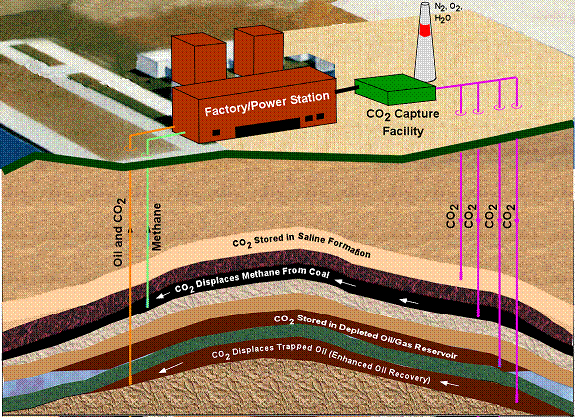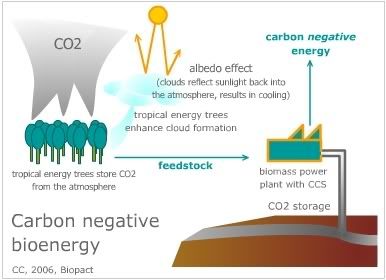Going radically carbon-negative: biomass carbon sequestration
 Everything the fossil fuel industry does, can and will be used against it. The scientific consensus is that climate change is quickly approaching a 'tipping point' after which there is no stopping it, with dire consequences for the entire planet. Currently existing greenhouse gas mitigation policies and instruments -- from Kyoto and the European carbon market to voluntary and techno-optimist schemes followed by individual US states -- probably do not suffice, unless they are radically strengthened today. With the stellar growth of new carbon and coal-intensive economies like India and China, who pump out enormous quantities of CO2 each year, the prospects do not look good.
Everything the fossil fuel industry does, can and will be used against it. The scientific consensus is that climate change is quickly approaching a 'tipping point' after which there is no stopping it, with dire consequences for the entire planet. Currently existing greenhouse gas mitigation policies and instruments -- from Kyoto and the European carbon market to voluntary and techno-optimist schemes followed by individual US states -- probably do not suffice, unless they are radically strengthened today. With the stellar growth of new carbon and coal-intensive economies like India and China, who pump out enormous quantities of CO2 each year, the prospects do not look good.Add the recent scientific findings that planting trees as a strategy to mitigate global warming is pointless, and things look even worse. In fact, the scientists warned that such 'feel good' strategies are dangerous, because planting trees outside the tropics could even exacerbate the situation and result in a net warming effect (earlier post and a good overview at the BBC). However, planting trees in the tropics works, because there they help the formation of clouds which reflect sunlight back into the atmosphere (the albedo effect), resulting in a global cooling effect.
Carbon sequestration
So even though current policies, techniques and investments aimed at reducing the amount of carbon that enters the atmosphere are good, they probably do not suffice. However, the fossil fuels industry for its part is working hard to develop technologies that may speed up things. Technologies are in the making to capture carbon dioxide from large point sources such as power plants and to store it away safely instead of releasing it into the atmosphere. Systems for the capturing of CO2 are already commercially available for large CO2 emitters. Storage of CO2, on the other hand, is a relatively untried concept and as yet no power plant operates with a full 'carbon capture and storage' (CCS) system (click to enlarge image).
But CCS technologies are receiving massive R&D funds and they do show a lot of promise. Applied to a modern conventional power plant, they could reduce CO2 emissions by approximately 80-90 % compared to a plant without CCS. Storage of the CO2 is envisaged either in deep geological formations, deep oceans, or in the form of mineral carbonates. Geological formations are currently considered the most promising, and these are estimated to have a storage capacity of at least 2000 Gigatonnes of CO2. The International Panel on Climate Change estimates that the economic potential of CCS could be between 10 % and 55% of the total carbon mitigation effort until year 2100.
The idea: going carbon negative with biofuels
The good thing is that these technologies, designed for fossil fuel plants, can in principle be applied to power plants that burn 100% biomass or biogas. Biomass is already being co-fired with coal in over 150 large plants, and some of those rely entirely on the green feedstock (earlier post). Similarly, large biogas power plants that are fuelled entirely by the green gas, made from dedicated energy crops, are being developed in Europe.
Now if CCS technologies were applied to power plants that are fuelled 100% by biomass or biogas, they would become radically carbon negative. Let us have a closer look at this idea:
 bioenergy :: biofuels :: energy :: sustainability :: climate change :: carbon dioxide :: fossil fuels :: carbon capture and storage :: CCS :: carbon sequestration :: biogas :: biomass :: carbon negative ::
bioenergy :: biofuels :: energy :: sustainability :: climate change :: carbon dioxide :: fossil fuels :: carbon capture and storage :: CCS :: carbon sequestration :: biogas :: biomass :: carbon negative :: If CCS is applied to a coal or natural gas fired plant, the amount of CO2 pumped into the skies is reduced substantially. But there is still a net-contribution of some 10 to 20%. Impressive, but not enough. All the while, we are approaching the dangerous global warming tipping point. So we must become more radical. We not only have to reduce our emissions; if possible, we should get the excess amount of CO2 that is already present in the atmosphere, out.

In principle, there are no technical barriers to applying CCS technologies to biomass and biogas power plants. Such plants are basically of the same design as ordinary fossil fuel plants.
The difference is in the work done by the fuel that is being used. In 'CCS-biofuel plants' the biomass feedstock used would suck CO2 out of the atmosphere as it grows. When the biomass or biogas is then burned to generate power, we capture and store it. New biomass grown for energy sucks out more CO2 out of the air... and so the cycle would no longer be merely carbon-neutral, but drastically carbon-negative.
This might be one of the most effective and most widely applicable ways of speeding up carbon emission reduction efforts. Why stop at using CCS technologies to reduce the CO2 emissions of coal and natural gas-fired plants, when such plants can be adapted to burn carbon-neutral biofuels the CO2 of which can be sequestered?
Dedicated energy crops could be grown in the tropics in vast quantities, and the biomass exported to modern 'CCS-biofuel plants' in the industrialised and rapidly industrialising economies of this world. Alternatively, biogas can be locally produced from municipal, agricultural or industrial organic waste, or derived from dedicated energy crops (which can also be grown in the developing world).
Geo-engineering the planet
We stress the fact that the biomass to be used in such radically carbon negative systems should be grown in the tropics. It is there that these energy crops yield the greatest global warming reduction effect. In the tropics, energy crops not only store carbon dioxide, they also contribute significantly to the albedo effect.
If enough energy crops are planted, medium-rotation and cyclical harvesting schemes could be envisioned that make optimal use of the albedo effect. The energy crops would be grown not only to store carbon (that will later be sequestered via CCS technologies), they would also be grown to cool the planet by inducing the formation of clouds that reflect sunlight back into the atmosphere.
This is just a very rough, non-scientific idea, that would have to be checked for its merits. But one thing is certain, the sooner CCS-technologies become viable, the sooner we can go radically carbon negative with biomass. We should support the development of CCS technologies, not to free coal and gas of their climate destructive reputation, but because everything the fossil fuel industry does, can and will be used against it.
We think 'biomass carbon sequestration' based on energy crops grown in special zones around the equator, might be a safer and more feasible concept than some of the other 'geo-engineering' ideas that are out there. Because indeed, scientists have begun to think of ways to engineer ourselves out of disaster, if global warming were to reach the irreversible and dangerous tipping point so many are beginning to fear.
Some of their ideas are literally out of this world: shooting millions of tiny mirrors into space which would deflect sunlight and cool the planet; or seeding the oceans with iron particles, so that massive algae blooms would suck carbon out of the atmosphere and store it. More recently, an economist-inventor launched the idea that huge plastic pumps in the oceans could be used to pump up nutrient-rich water from the bottom, which algae would feed on. The algae would then be eaten by salps who excrete dense carbon pellets that sink to the bottom, thus putting atmospheric carbon away. However, the idea is unfeasible, because it would take a huge amount of petroleum to manufacture the vast number of plastic ocean pumps. Another idea is to simulate the effects of a volcanic mega-eruption by pumping sulphur into the atmosphere, which would result in a net cooling effect. These controversial ideas will only be considered more seriously if the disaster is clearly knocking on our door.
In the meantime, we need more realistic alternatives. Our idea of applying CCS-technologies to biomass and biogas-fired power plants may be one such concept.
No other renewable energy system can ever be so carbon-negative as the one we propose. Both wind, solar, nuclear, hydro, wave, tidal and geothermal are all carbon-neutral at best and most often slightly carbon-positive (because energy is used to mine, process and transport the resources used in the manufacture of these technologies, and also during their installation, maintenance and operation.)
Biopact team
Note: even though the above concept is really simple, we haven't found any good references so far to the idea of capturing and sequestring the CO2 emissions from biomass-fuelled power plants, the fuel of which is grown as part of a geo-engineering effort in the tropics. If you have, please let us know.
 -------------------
-------------------
 Spanish company Ferry Group is to invest €42/US$55.2 million in a project for the production of biomass fuel pellets in Bulgaria.
The 3-year project consists of establishing plantations of paulownia trees near the city of Tran. Paulownia is a fast-growing tree used for the commercial production of fuel pellets.
Spanish company Ferry Group is to invest €42/US$55.2 million in a project for the production of biomass fuel pellets in Bulgaria.
The 3-year project consists of establishing plantations of paulownia trees near the city of Tran. Paulownia is a fast-growing tree used for the commercial production of fuel pellets.









0 Comments:
Post a Comment
Links to this post:
Create a Link
<< Home